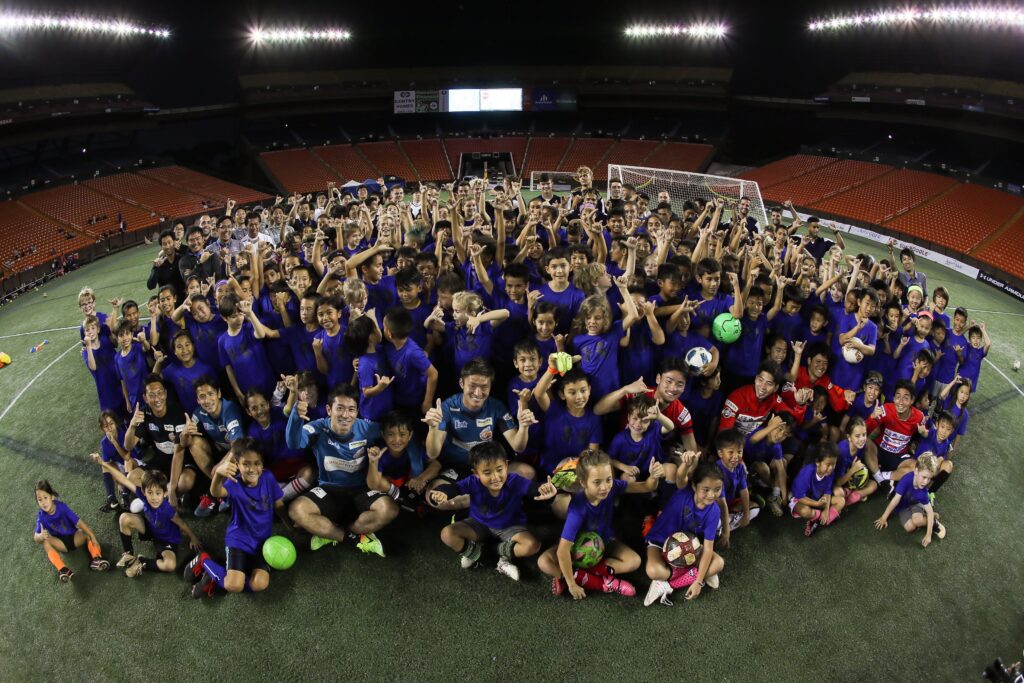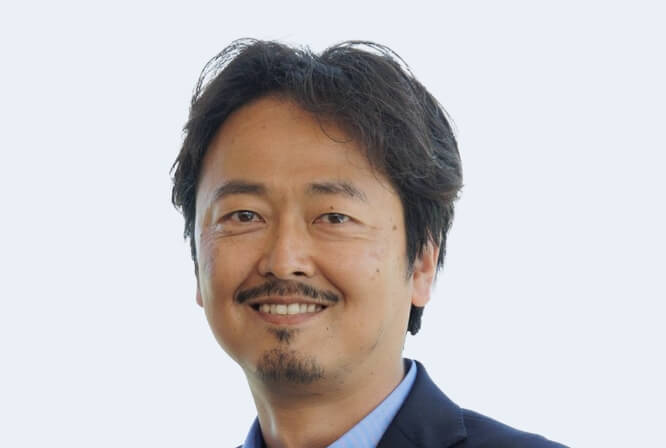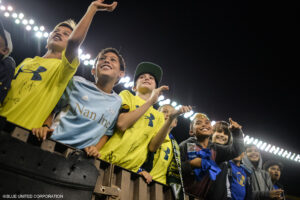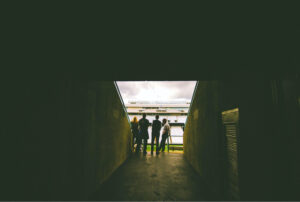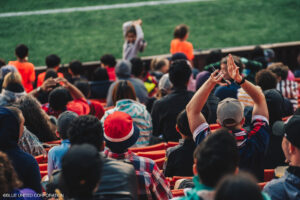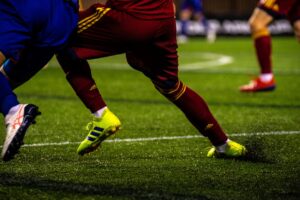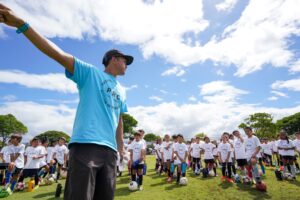2023年8月5日、米国ハワイ州において「Pacific Rim Cup Keiki Soccer Clinic 2023」が開催された。元サッカー日本代表3名とハワイ出身の元プロサッカー選手がスペシャルコーチとして参加したこのイベントは、300名を超える子どもの笑顔や歓声で賑わった。
しかしながら、これは単なる子どもたちのためのサッカー教室ではなかった。このイベントに込められた思い、狙い、そして2008年から継続しているプロジェクトの意味を考えてみる。
ハワイで開催されるサッカーの国際イベントPacific Rim Cup
Pacific Rim Cup (以降PRC)は2018年に第1回大会が開催された。日本のサッカークラブとMLS(Major League Soccer)のチームが対戦するサッカーの国際マッチである。試合だけではなく、子ども向けのサッカークリニックや記者会見、パーティなど数日間にわたって行われるイベントで、ホノルルマラソンやテニスの全米オープンなどをイメージしていただければ分かりやすいかもしれない(概要は、こちら)。
イベントの前身はパンパシフィック・チャンピオンシップ(2008年、2009年)である。当時MLSに所属し、これを企画した中村武彦氏(現Blue United Corporation[BU社] President & CEO)がBU社を設立し、このイベントを主催するようになった。
2018,2019年と開催したものの、コロナ禍の影響で2020,2021年は休止。2022年に子ども向けクリニックのみを復活させた。そして2023年も同様にクリニックが開催された(模様は、こちら)。
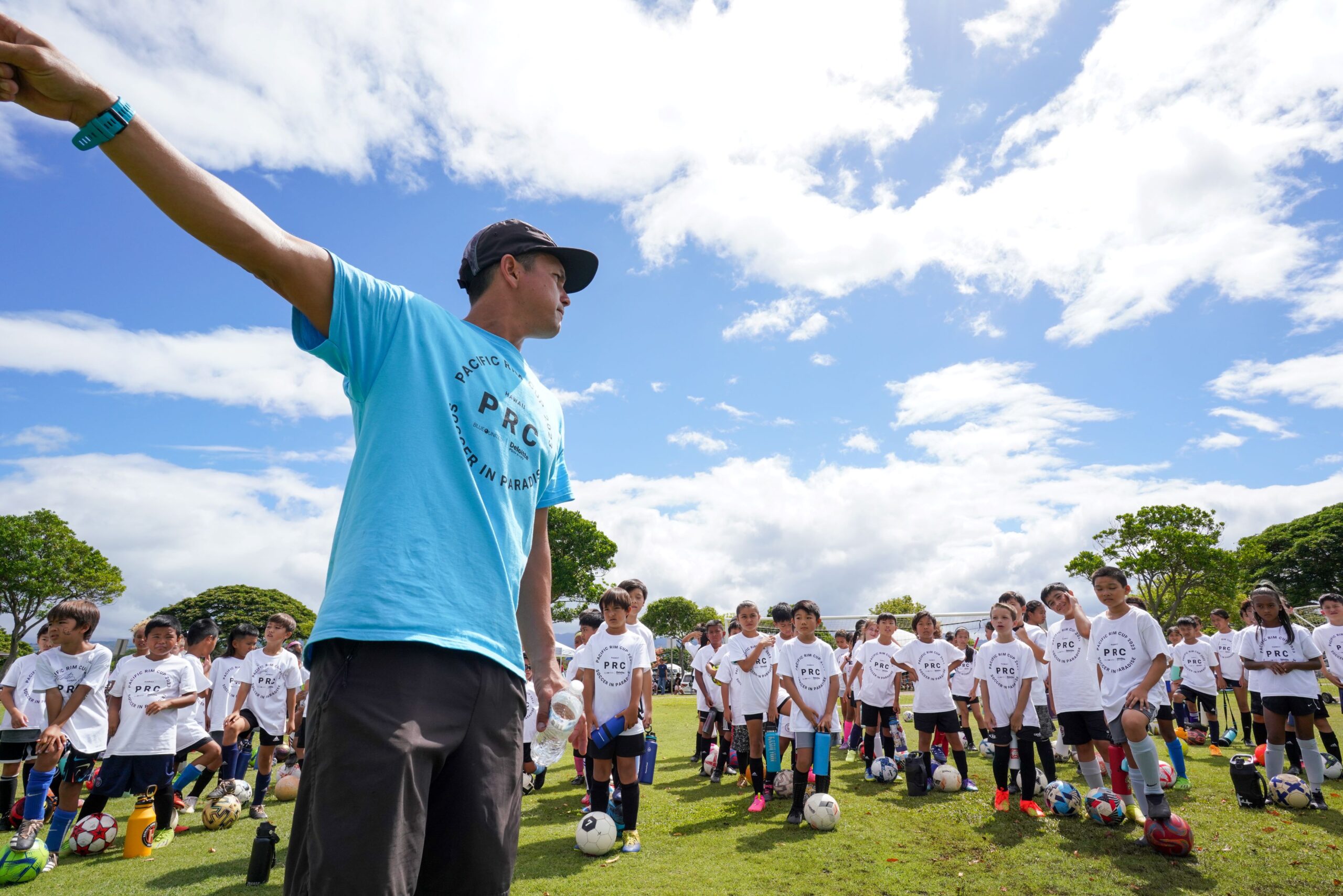
プロスポーツがない地域でできること
ご存じの方もいらっしゃるかと思うが、ハワイにはプロスポーツは存在していない。もちろんプロサッカーリーグもなく、グラウンドやスタジアム、ロッカールームなど含めてプロが興行を行う環境にはない。地元住民がプロ選手を間近で見ることもめったにない(NBAのプレシーズンマッチやNFLのオールスター戦の実績あり)。そのような土地に、日本や米国などからプロサッカークラブが来て試合を行ったり、子ども向けのサッカー教室や、地元の企業や有力者とのパーティを行ったりするのである。
単純に見れば、地域活性化や経済効果、プロ選手とふれあうことで子どもたちがいきいきしたり、将来の夢の選択肢にプロスポーツ選手が増えたりということが考えられるだろう。もちろん、そのような効果をもたらすことも分かっているが、それだけではない。「プロスポーツの試合」というコンテンツに対する既得権益がない状況では、できることに制約がないのである。
過去には、このコンテンツを活用してテクノロジーの実証実験を行った企業や、米国進出の足がかりとした企業などがある。スポンサーアクティベーションのアプローチとして、協賛側が狙いと目的を持ってビジネス上のメリットを直接得るためのアクションを取ることができる。日本でもアクティベーションの大切さは広まってきている。このハワイのコンテンツで、「アクティベーション」自体の実証実験をしてみるのも良いのではないだろうか。
そして、もう一つ大切なことがある。それがハワイにおける地元住民のコミュニティとの結びつきである。
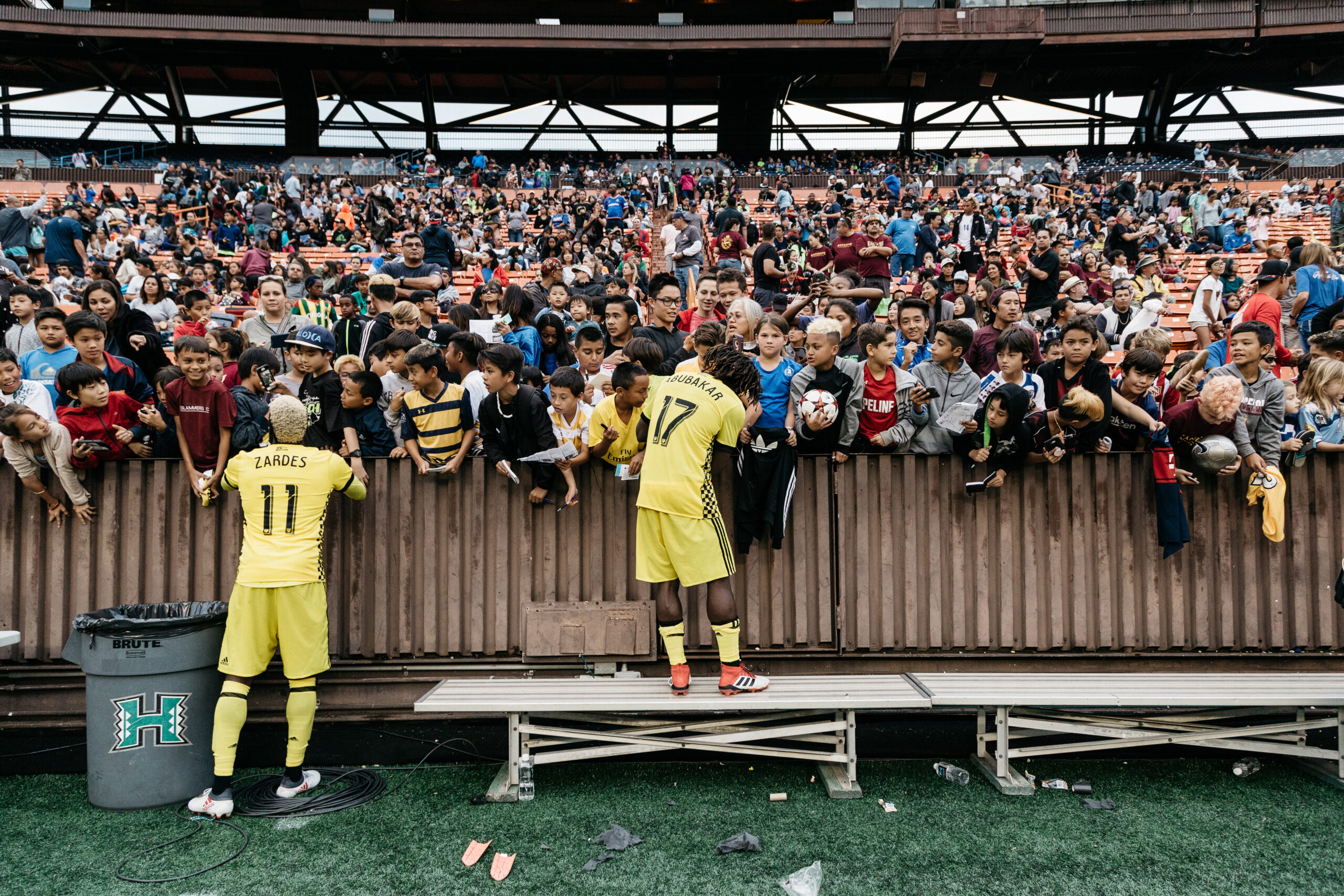
地域コミュニティとの結びつき、浸透
世界的な観光地であるハワイは、コロナ禍からの回復で2022年は900万人を超える観光客が訪れた。ハワイ州産業経済開発観光局(DBEDT)が公表した「2022年秋のハワイ住民意識調査」では、地元住民が観光マネジメントに対して多少ポジティブに変化していることが報告されているものの、地元コミュニティとのコミュニケーションは大切だとしている。
観光客の約半数が訪れるオアフ島では、そのほとんどがワイキキで過ごす。それ以外の地域では地元住民が生活しており、彼らは自分たちのテリトリーに他国の人が入ってくることを歓迎していないという。
2023年にPRCが開催されたWaipio Peninsula Soccer Complexはオアフ島西部にあり、観光客が訪れる場所ではなく地元住民のエリアである。ここにいきなり外国人がやって来て子どもたちにサッカーを教えるといっても、簡単に人が集まることは期待できない。この場所で開催するには「開催する理由やメリット」と「地元コミュニティの受け入れ」が必要だ。
これを中村氏は2008年のパンパシフィック・チャンピオンシップ開催時から地道に取り組んできている。地元の有力者、住民、そして企業、スペシャルコーチとして参加しているハワイ州出身の元プロサッカー選手の協力も大きな支えになっている。
イベント開催に必要なリソースは、全て地元で調達することも徹底している。ボール、弁当、ドリンクだけでなく、地元の学生を含むボランティアスタッフは40名に上る(クリニック開催時の人数。PRC全体開催の場合は200名)。
地元メディアへのアプローチにも抜かりはない。開催当日のインタビューはもちろん、その日の夕方にはニュースとして大きく報道される。また、参加者の保護者同士の交流も盛んだ。元々友人・知人の関係ではなくても、このイベントをきっかけに交流・親交が始まり、コミュニティの拡大や活性化にもつながっている。
過去には実際の経済効果を試算して公表(2019年開催で210万USドル)しており、今回はその社会的投資対効果(Social Return On Investment)の試算も現在行っている。

私たちがPRCから学ぶこと
この活動を単なる「ハワイへの慈善活動」と捉えるのは間違いである。たった数日同行しただけだったが、多くの学びと気付きがあった。
まず、当日の参加者。チケットは、無償で参加者を募集した昨年は即日受付終了し、初めて有償化した今年も開催前の7月末には完売した。また、女の子の参加者が非常に多かったこと。全体の半分以上は女の子だった。これには特別コーチとして参加された橋本英郎氏や海堀あゆみ氏も驚いていた。日本だと「女子向け」という形でないと、ここまでの人数は集まらないという。男女問わずサッカーが浸透している米国の状況を実感した光景だった。
そして何よりも強く印象に残ったのは、地元のコミュニティとの調整である。前述したようなきめ細やか、かつ根気強いコミュニケーションを取っている。日本人とは細かさや時間の感覚が違う人たちを相手に、とても粘り強い交渉と調整を行っていた。前日に段取りが変更になったり、当日も約束どおりに事が運ばなかったり。相手に責任を押しつけるのではなく、「では、どうすれば良いか」を念頭に忙しく動き回っていたスタッフの姿が目に焼き付いている。
縁もゆかりもない地域のコミュニティに入り込むことの難しさを知る良い機会となった。日本のスポーツにおいても「地域密着」を重要な柱と捉えているクラブや団体は多い。その地域で新しいクラブを立ち上げるとき、実業団から地域クラブに転換するとき、経営の観点での事業売却などにより拠点が変更になるとき、こういったときに、例えば閉鎖的なコミュニティと調整する必要が発生したらどうすべきか。閉鎖的ではなかったとしても、新しい土地でどうやったら受け入れてもらえるのか。PRCはまさにこれを実践している。ここで蓄積されたノウハウは日本のスポーツ界においても必ず重宝されるだろう。
期間中印象に残ったシーンをもう一つ紹介したい。会場への車中でもスタッフ間で議論が行われていた。今回のイベントにおいて無償でドリンクを提供したいという企業があったという。参加者に提供できること、そのコストが無償であることをメリットとして受け入れるべきという主張と、「無償(スポンサーフィーの支払いがない)で、自社商品のPR」をされるとイベントの価値が下がるという主張、商品だけ置いていかれても管理や運搬にコストがかかるという主張がぶつかる。イベントの価値をどう高めていくか、ハワイ在住者にとってのメリットは何かという視点が常にあることは刺激的だった。
PRCが持つ意味、それは我々が日本のスポーツビジネスに必要なことを直接体験しながら検証し、そして学ぶことができることにあるのだと確信した体験だった。そしてその先には欧州、南米に次ぐ、第三のサッカー市場をハワイにつくるという中村氏の野望があることも忘れてはならない。

[English]
Learning from the Pacific Rim Cup’s Infiltration into Local Communities
On August 5, 2023, the “Pacific Rim Cup Keiki Soccer Clinic 2023” was held in Hawaii, USA. This event, which featured three former Japanese national soccer team members and a former professional soccer player from Hawaii as special coaches, was filled with the smiles and cheers of over 300 children.
However, this wasn’t just a soccer clinic for kids. Let’s delve into this event’s intentions, goals, and meaning, which has been ongoing since 2008.
The International Soccer Event in Hawaii – Pacific Rim Cup
The Pacific Rim Cup (PRC) ‘s inaugural event in 2018 featured matches between Japanese soccer clubs and Major League Soccer (MLS) teams. It’s not just about the matches; it’s a multi-day event with soccer clinics for children, press conferences, and parties. Think of it as similar to events like the Honolulu Marathon or the U.S. Open in tennis (you can find an overview here).
The precursor to this event was the Pan-Pacific Championship held in 2008 and 2009. At the time, Mr. Takehiko Nakamura, who was part of the MLS and organized this event, went on to establish Blue United Corporation (BLU), which currently serves as the organizer of the Pacific Rim Cup.
While the event was held in 2018 and 2019, it took a hiatus in 2020 and 2021 due to the COVID-19 pandemic. In 2022, only the Keiki Soccer Clinic was revived, and in 2023, the clinic was once again held (you can see the details here).
What Can Be Done in Areas Without Professional Sports
As you may already know, Hawaii does not have professional sports. There’s no professional soccer league, and there isn’t an infrastructure for professionals to stage events, including fields, stadiums, and locker rooms. Local residents rarely get the opportunity to see professional athletes up close, although there have been some NBA preseason games and NFL All-Star matches. In such a place, professional soccer clubs from Japan and the United States come to play matches, conduct soccer clinics for children, and host parties with local companies and influential figures.
At a glance, this can contribute to community revitalization, economic effects, and enriching the lives of children, potentially expanding their career aspirations to include professional sports. Of course, it is understood that such effects can be achieved, but that is not the only aspect. In a situation where there are no entrenched privileges held by rights holders for the content of “professional sports events” and where there are no existing constraints, partner companies have the freedom to explore what they can do.
In the past, companies have utilized this content for technology proofs-of-concept or as a stepping stone for entering the U.S. market. As an approach to sponsor activation, sponsors can take actions with specific aims and objectives to benefit their business directly. The importance of activation is also gaining recognition in Japan. Perhaps it would be worthwhile to consider conducting a proof-of-concept experiment on “activation” itself within this Hawaii content.
And there’s one more crucial aspect: the connection and integration with the local community in Hawaii.
Connecting and Infiltrating the Local Community
Hawaii, a globally renowned tourist destination, welcomed over 9 million visitors in 2022 as it recovered from the COVID-19 pandemic. A “2022 Fall Hawaii Resident Attitude Survey” released by the Department of Business, Economic Development, and Tourism (DBEDT) of the State of Hawaii indicates that while residents have become somewhat more positive toward tourism management, communication with the local community remains essential.
In Oahu, where nearly half of the tourists visit, most spend their time in Waikiki. In other neighborhoods, you’ll discover the vibrant homes of local residents who take great pride in their community and value the close connections they’ve formed over time.
The Waipio Peninsula Soccer Complex, where the 2022 and 2023 PRC Keiki Soccer Clinic were held, is in the western part of Oahu and not a place frequented by tourists but rather an area for local residents. It’s not easy to gather people instantly for foreigners to come and coach children soccer in this place. To hold an event here, it’s essential to have a “reason and benefits for hosting” and acceptance from the local community.
Mr. Nakamura has diligently worked on this aspect since the Pan-Pacific Championship 2008. The support of influential figures in the local community, residents, companies, and former professional soccer players from Hawaii who participated as special coaches has been a significant pillar of support.
All the resources required for hosting the event are sourced locally. This includes printing, procurement of equipment, balls, lunches, and drinks, and a volunteer staff of up to 40 people (during clinic sessions; it’s 200 for the entire PRC).
Their approach to local media is also meticulous. Interviews on the event day are given and receive significant coverage as news in the evening. Moreover, there’s active interaction among the parents of participants. Friendships and acquaintanceships often begin, leading to the expansion and revitalization of the community, even among people who were not initially friends or acquaintances.
In the past, they have calculated and published the actual economic impact (USD 2.1 million for the 2019 event), and we are currently working on calculating the social return on investment (SROI) for this year’s event.
What We Can Learn from PRC
Considering this activity as mere “charity for Hawaii” would be a mistake. Though I only accompanied them for a few days, there were numerous lessons and insights to be gained.
Firstly, the participants on the day of the event. Tickets were free for last year’s event and sold out in 48 hours. Even this year, when they introduced a paid ticket for the first time, it sold out by the end of July. What was particularly striking was the large number of female participants. More than half of the participants were girls. This surprised even special coaches like Mr. Hideo Hashimoto and Ms. Ayumi Kaihori. In Japan, without a specific “for girls” focus, such numbers wouldn’t be achieved. It was a scene that highlighted the prevalence of soccer in the U.S., regardless of gender.
Most importantly, what left a strong impression was the coordination with the local community. As mentioned earlier, their communication is meticulous and patient. They conduct persistent negotiations and coordination that might differ from the Japanese approach. Changes in plans happened the day before, and things didn’t always go as promised on the event day. Rather than assigning blame to the other party, the staff were always busy finding solutions with the mindset of, “What can we do?” Their determination was evident.
It was a valuable opportunity to understand the challenges of infiltrating a community in a region with no prior connections. In Japanese sports, the concept of “local engagement” is also considered a vital pillar. When starting a new club in a community, transitioning from a corporate team to a local club, or relocating a base due to business reasons, how should you negotiate with a tight-knit community if that’s the case? Even if the community isn’t exclusive, how can you gain acceptance in a new location? PRC is actively practicing this, and the knowledge accumulated here will undoubtedly be invaluable in Japan’s sports industry.
I’d like to share one more scene that left an impression during the event. Discussions were ongoing among the staff, even during the car ride to the venue. A company wanted to provide drinks for free at this year’s event. Discussions were made for accepting the offer as it provides a benefit to the participants without cost and against it as it could lower the value of the event by allowing free promotion of the company’s products. There were also concerns about the costs associated with managing and transporting the products, even if they were provided for free. The constant consideration of how to enhance the event’s value and what the benefits are for Hawaii residents was stimulating.
The significance of PRC lies in the fact that we can directly experience, validate, and learn what is necessary for Japan’s sports business. Let’s not forget Mr. Nakamura’s ambition to create a third soccer market in Hawaii, following Europe and South America.

